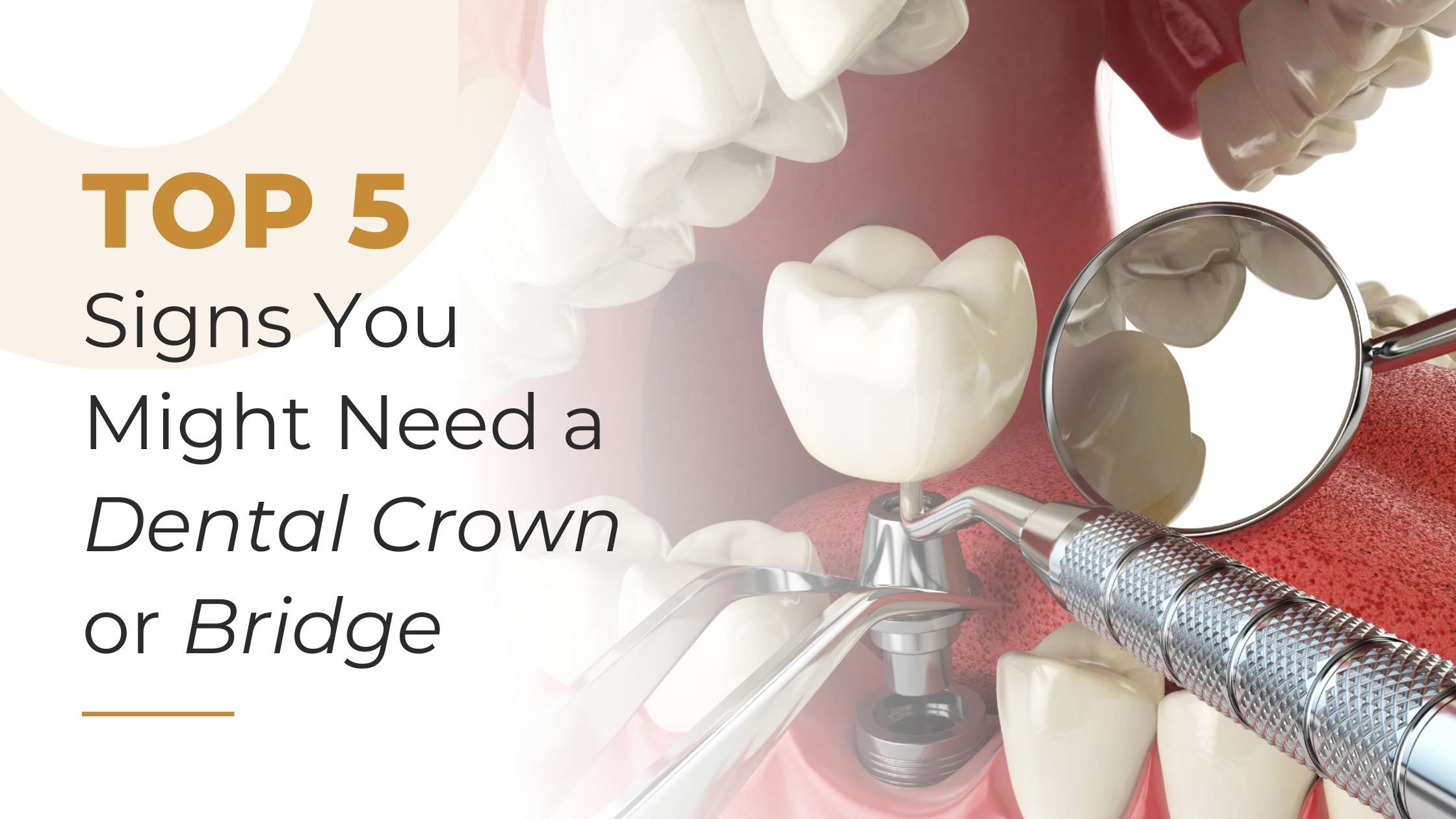Top 5 Signs You Might Need a Dental Crown or Bridge

Here are the top 5 signs you might need a dental crown or bridge, and why ignoring them could make things worse in the long run.
- You Have a Severely Damaged or Decayed Tooth
If a tooth has suffered extensive decay, a simple filling might not be enough to restore its function or appearance. Large cavities can weaken the tooth structure, making it prone to breaking or further infection.
A dental crown acts like a cap that covers the entire tooth, restoring its shape, size, strength, and appearance. It’s especially beneficial when there’s not much natural tooth left.Why it matters: Leaving a badly decayed tooth untreated can lead to severe pain, infection, and even tooth loss. A crown can help save the tooth and prevent the need for an extraction.
- You’ve Lost One or More Teeth
Missing teeth affect more than just your smile—they can make it difficult to eat, speak, and maintain proper oral hygiene. When one or more teeth are missing, the surrounding teeth may begin to shift, leading to alignment problems.
This is where a dental bridge comes in.
A bridge fills the gap left by missing teeth using artificial teeth anchored by crowns placed on the adjacent natural teeth.
Why it matters: A dental bridge not only restores your smile but also prevents long-term dental complications caused by tooth movement and jawbone deterioration.
- You Have a Cracked, Chipped, or Worn-Down Tooth
Accidents happen—a sudden bite on something hard or a fall can cause cracks or chips in your teeth. Similarly, people who grind their teeth (a condition called bruxism) may experience significant enamel wear over time.
In such cases, a dental crown can protect the compromised tooth and restore its appearance and function.
Why it matters: Leaving a cracked or chipped tooth untreated may allow bacteria to enter the pulp (inner tissue), increasing the risk of infection and root canal treatment.
- You’ve Had a Root Canal Treatment
A root canal removes infected pulp tissue from inside the tooth, effectively saving it from extraction. However, after the procedure, the tooth becomes more fragile and susceptible to breaking.
To protect it, dentists often recommend placing a crown over the treated tooth.
Why it matters: Without a crown, the weakened tooth is at a much higher risk of fracture, especially on molars that handle heavy chewing forces.
- Your Existing Crown or Bridge Is Failing
Dental work doesn’t last forever. Over time, old crowns or bridges may become loose, cracked, or stained. You might also notice discomfort while chewing, bad breath from trapped food particles, or visible wear and tear.
If you already have a dental crown or bridge, it’s important to monitor its condition with regular check-ups.
Why it matters: A failing crown or bridge can lead to new dental issues, including decay of the underlying tooth, gum infection, or shifting of surrounding teeth. Replacing it promptly helps preserve your oral health.
Bonus: You Want to Improve the Appearance of Your Smile:
While crowns and bridges are often used for restorative purposes, they can also be part of a cosmetic dentistry plan. Discolored, misshapen, or uneven teeth can be enhanced with tooth-colored crowns that blend seamlessly with your natural smile.
Why it matters: If you’re self-conscious about your smile, dental crowns or bridges could be the confidence boost you need—offering both function and aesthetics.
When to See Your Dentist
If you’re experiencing any of the signs above—or simply haven’t had a dental check-up in a while—it’s a good idea to schedule a consultation. Early intervention can often save time, money, and discomfort down the road.
Modern crowns and bridges are more durable and natural-looking than ever, thanks to advancements in materials like ceramic, zirconia, and porcelain-fused-to-metal.
How to Care for Dental Crowns and Bridges?
Once you’ve received dental crowns or bridges, proper care is essential to maintain their longevity and function. Although these restorations are durable, they still require good oral hygiene habits. Brushing twice daily with a non-abrasive toothpaste, flossing around the crowned or bridged teeth, and using an antibacterial mouthwash can prevent plaque buildup. Avoiding hard or sticky foods and visiting your dentist regularly for check-ups will ensure your dental crowns and bridges stay in excellent shape for years to come.
Conclusion:
Whether you’re dealing with a damaged tooth, missing teeth, or old dental work that needs replacing, dental crowns and bridges offer reliable, long-lasting solutions. Recognizing the warning signs early and seeking professional care can help preserve your oral health and restore your smile.
For reliable and long-lasting solutions, dental crowns and bridges are a proven way to restore both the function and aesthetics of your teeth. At Sakthi Smile Craft, we offer customized treatments that ensure a perfect fit and natural appearance for every smile.
Your teeth are meant to last a lifetime—make sure you’re giving them the support they need.
